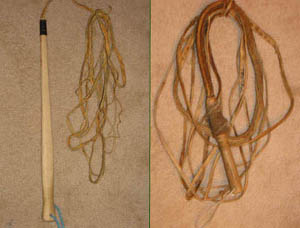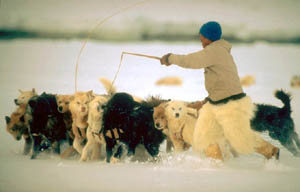In This Issue...
*
F.I.D.O.: Daniel Annanack
*
F.I.D.O: Mark Brazeau and Qimmiit Utirtut
*
Wolf Problems in Kuujjuaq
*
Inuit Dogs of Mawson Station
*
Differences in Mushing: Greenland and Arctic Canada, Part II
*
Inuit Produced Information Resources
*
In the News
*
Book Review: 1000 Days with Sirius
*
Product Review: 3Mô Precise Skin Stapler
*
IMHO: A Time for Action
Navigating This
Site
Index of articles by subject
Index
of back issues by volume number
Search The
Fan Hitch
Articles
to download and print
Ordering
Ken MacRury's Thesis
Our
comprehensive list of resources
Talk
to The
Fan Hitch
The Fan
Hitch home page
ISDI
home page
Editor's/Publisher's Statement
Editor: Sue Hamilton
Webmaster: Mark Hamilton
The Fan Hitch welcomes your letters, stories, comments and suggestions. The editorial staff reserves the right to edit submissions used for publication.
Contents of The Fan Hitch are protected by international copyright laws. No photo, drawing or text may be reproduced in any form without written consent. Webmasters please note: written consent is necessary before linking this site to yours! Please forward requests to Sue Hamilton, 55 Town Line Rd., Harwinton, Connecticut 06791, USA or mail@thefanhitch.org.
This site is dedicated to the Inuit Dog as well as related Inuit culture and traditions. It is also home to The Fan Hitch, Journal of the Inuit Sled Dog.
Greenland and Canadian Mushing, Part II
Dog Whips
by Donald Mearns
Pangnirtung, Nunavut, CANADA

| Greenlandic whip, wood shaft of ash | Canadian whip, stitched style, quite heavy Photo: Mearns |
The handles are quite different. The Canadian whip handle is bound into the lower part of the braid and often has a canvas or sealskin filler that the braid is made around. This adds stiffness and body to the lower part of the whip. The Greenlandic whip is an approximately 46cm-long (18") wooden stick with the seal or whale skin strand whip bound on to the end.
Both the Canadian and Greenlandic whips can be any length: 6m. (25'), 9m. (30'), 10.5m. (35'). In my experience these whips are about 6m. (25') long but the length also depends how long your dog traces are. To get one single continuous strand leather for a whip from a bearded seal that is only about nine feet long nose to rear flippers, you cut the skin from the seal in one continuous line round and round the body.

Spring 1993 in the Qaanaaq/Thule region
of Greenland.
Photo: L. Reimers
Courtesy
of Greenland Tourism.
Because Greenland style whips are very light in comparison to the heavy Canadian version, they are more difficult to manage in the wind but are very simple and easy to use with little skill, and they crack easily as compared to thicker, short-handled Canadian whips. The Canadian whip is much heavier, making it better in windy conditions, but it has more of a learning curve to use. There is more technique to using a Canadian whip and they can be tricky if you try to rush things and don't concentrate on what you are doing. I chopped a 2 cm lump of flesh out of my nose one day with a frozen whip when the dogs were fighting. I have also struck myself about the back of the head with the whip while sitting on the qamutiq in strong following winds. The best story was when a good friend, Allan, was bending over while harnessing dogs. When two dogs started to fight just beside him, another friend's wife who was working with him to harness the dogs went to whip the two offending animals. She missed and cracked Allan square on the ass by accident. Allan told me he said to her, "More. I like it!" He admitted though it hurt like hell, and he was just kidding about asking for more.
Among Canadian whips there are a number of designs. Every musher has his style and variations come from the preferences of the individual. Materials are generally what is available. Bearded seal is tough but whale leather is the best as it is very strong but becomes very flexible. In Pangnirtung the whips are generally braided from six or eight strands of mujak (beluga whale leather) with bearded seal or whale leather as the main whip rope cut as one continuous piece to a taper, quite a skill. It is a very smelly process to make the mujak as the maktaq has to age until it is igunak and then the flesh falls away from the leather. There are also eight strand whips which are a work of art. Other styles have walrus strips sewn together for the body of the whip with a bearded seal rope again cut in a continuous taper.

The whip is lazily swished from side to
side to keep
this Canadian team
calmly laying down even though over a
dozen teams are
preparing
for a mass
start.
Photo:
Hamilton
Dog whips are necessary for a variety of reasons, but their use should never be abused! "If you whip your dogs to go faster you will always be whipping them to go faster," Aksayuk Etuangat said. Verbal commands are the best form of control but there are times when the whip is very necessary for turning the dogs, keeping them down when stopped, or correcting a dog that is disturbing the team. I always found that if a dog felt the whip once, after that the show of the whip and a good growl from me was enough. A good crack behind the team will often remind them of the job at hand. The whip doesn't have to make contact, just the sound is enough. Controlling ten to fifteen dogs doesn't come easily or without some persuasion.